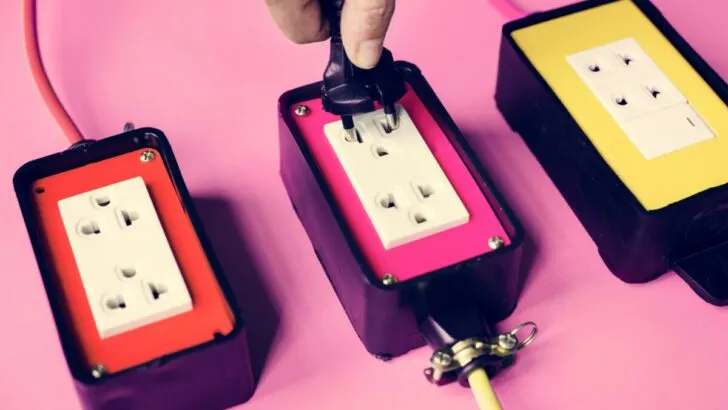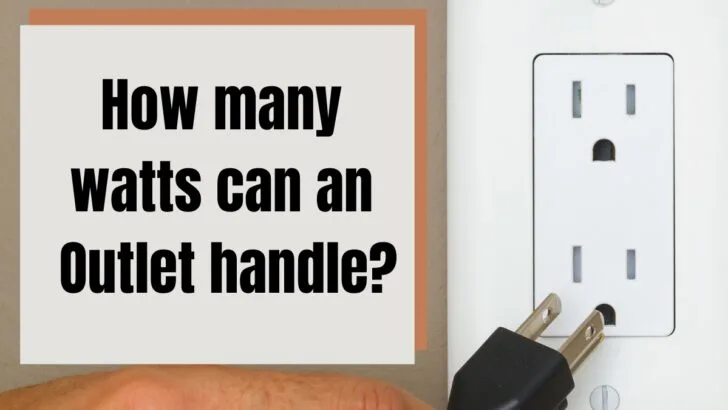With so many devices and appliances in our homes these days, it can be difficult to have everything plugged into a single outlet without overloading it.
A standard outlet can handle roughly 1,500 watts. However, this figure can range from 1,320 to 5,150 watts depending on the voltage of your devices and appliances, as well as the size of your breaker.
The number of watts an outlet can handle often varies depending on your voltage needs and the amperage of your breaker.
How Many Watts Can an Outlet Handle?
As a general rule of thumb, a standard power outlet can handle around 1,500 watts. This is the power delivery that you should keep in mind for most outlets in the United States until you confirm that your breaker can handle more.
It’s important to understand that the amount of power that your outlet can handle depends much more on the size of your breaker than anything else.
The bottom line is that the larger your breaker, the more power it can deliver to your home’s outlets.
Most home outlets can safely handle anywhere from 1,320 to 5,150 watts before being overloaded. That said, you should always stick to the standard 1,500-watt rule per outlet to be on the safe side unless you know for sure that your outlet and breaker can deliver more.
What Determines How Many Watts an Outlet Can Handle
Each outlet is different because every person has different power needs in their home. As a standard, homes are designed with outlets that can handle 1,500 watts, which is why you should keep this number in mind for most outlets in the United States.

However, there are a couple of important factors that will determine how the wattage capacity of an outlet, such as:
- Voltage
- Breaker size
In the United States, the standard voltage is 110V, whereas, in Europe and other parts of the world, 220V is the standard. Furthermore, each breaker can vary in size, with larger breakers naturally putting out more amps. This is a breakdown of how many watts an outlet can handle based on voltage and breaker size:
- 15 amp breaker with 110V outlet – 1,320 watts
- 20 amp breaker with 110V outlet – 1,760 watts
- 30 amp breaker with 110V outlet – 2,640 watts
What Are the Risks of Overloading an Outlet?
It’s easy to underestimate just how dangerous and damaging overloading an outlet can be. To ensure that your home and all of your devices are protected, never overload your outlets.
Electrical Fires
One of the biggest leading causes of domestic fires is related to electrical issues caused by overloading outlets.
An electrical fire in your home can potentially cause injuries and property damage. Given that most homes are designed with outlets that can handle 1,800 watts (15 amps ) at a time, breaching this threshold will almost certainly result in some kind of power issue, if not a fire.
Power Surges
In addition, to electrical fires, overloading outlets can also damage the device or appliance that you have hooked up. If you are not using a surge protector, overloading an outlet can easily fry anything that you have plugged into an outlet.
Power surges have notoriously been the cause of electronic devices getting damaged when they are hooked up. They can be caused by faulty wiring, lightning strikes, and most importantly overloading outlets.
A major power surge can cause upwards of 90% of all devices in your home to be destroyed if they are connected to an outlet.
How to Prevent Power Surges
The best way to prevent a power surge is to be aware of how many things you have plugged into your outlets so that you do not overload the breaker. Always confirm what your breaker and outlets can handle, and plug-in devices and appliances with your power wattage threshold in mind.
In addition, you can prevent your devices from getting damaged during a power surge by using surge protectors. A surge protector is a device that you plug into any outlet such as a powerstrip that allows you to connect other devices and appliances without having to worry about power surges.
The surge protector will absorb the surge and prevent any damage to whatever you have plugged in.
How Many Things Can Be Plugged Into a Power Strip?
A power outlet with only two plugs simply does not suffice for most households in the modern age. With more devices and appliances in people’s homes than ever before, it can be a struggle to find a place to charge your phone.
Luckily, power strips were invented to simplify our energy needs, but you still want to be careful with how many things you plug into a single strip. Your first limitation is going to be the number of plugs that are available, which on most strips is usually 6 to 8 plugs.
However, despite having more plugs available, you still need to consider how many watts you are using. Even with a powerstrip plugged in, you can still overload your outlet or the strip itself.
The same risks apply to overloading power strips as they do to outlets; you can potentially start an electrical fire or damage your devices if the strip does not have a surge protector.
What is the Recommended Circuit Load Per Outlet?
To ensure that your breaker does not trip and that your outlets are not overloaded, never breach 80% of your circuit load.
This implies that you should always stay 20% lower than the maximum amps and watts that your breaker and outlets can handle.
Key Takeaways to How Many Watts an Outlet Can Handle
A standard outlet can handle roughly 1,500 watts.
Outlets can handle 1,320 to 5,150 watts depending on the voltage of your devices and appliances, as well as the size of your breaker.
Overloading an outlet can result in electrical fires and power surges.
To avoid risks related to overloading outlets, never exceed 80% of the power capacity of the outlet and breaker.


